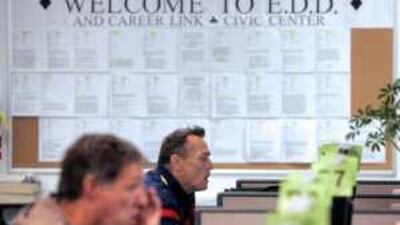The unemployment rate in the US jumped more than expected, to 9.7 per cent last month, the highest since 1983, prompting fears that weak consumer spending will make for a slow economic recovery next year. But while the percentage of those without jobs rose more than expected, the economy shed fewer jobs than economists had predicted, at a net total of 216,000 jobs, less than July's revised 276,000 and the fewest monthly losses in a year, according to the US labour department. Economists had expected the unemployment rate to rise to 9.5 per cent from July's 9.4 per cent, and job reductions to total 225,000. The so-called underemployment rate, which includes part-time workers who would prefer a full-time position and people who want work but have given up looking, reached a record 16.8 per cent. The rise in the jobless rate was largely because the number of unemployed Americans jumped by nearly 500,000 to 14.9 million, while only 73,000 people joined the civilian labour force. Those figures are from a different survey than the report on total job cuts. The civilian labour force usually grows as a recession winds down and optimism about finding work increases. But as long as Americans remain anxious about their jobs, consumer spending is not expected to rise enough to power a rebound. The figures increase concerns that the recovery forecast for the second half of this year will not prompt a turnaround in the US job market until next year. With the ranks of long-term unemployed nearing 5 million, workers are at risk of losing skills, making it even tougher for them to eventually find work. "The economy is no longer detonating, but we are still losing jobs," said David Rosenberg, the chief economist at Gluskin Sheff and Associates in Toronto. "It's going to be a very tough environment for the consumer." Rising joblessness underscores the judgment last week by Timothy Geithner, the US Treasury secretary, that it is too early to begin ending the unprecedented stimulus measures aimed at stabilising the economy. "The labour market lags behind the rest of the economy, so we are first going to have to see positive GDP growth," said Christina Romer, the chairman of the White House council of economic advisers. While 9.7 per cent unemployment is a tragedy, Ms Romer said, the pace of job losses had slowed from 741,000 in January. She said the Obama administration's US$787 billion (Dh2.89 trillion) financial stimulus was working to boost growth, although she declined to comment on whether a second effort would be needed. Revisions cut 49,000 from the payroll figures previously reported for July and June. The drop for July is now calculated at 276,000, up from the 247,000 previously reported. The latest numbers brought total jobs lost since the recession began in December 2007 to 6.9 million, the biggest fall in any economic slump since the end of the Second World War. Analysts in a survey by Bloomberg predicted that the unemployment rate would reach 10 per cent by early next year and average 9.8 per cent over the year. All major job categories recorded losses in August, with construction payrolls dropping by 65,000, factories cutting another 63,000 and retailers firing a net 10,000 people. * with agencies

Jump in US jobless stokes recovery fears
Silver lining for companies is that lower labour costs are likely to give a boost to their profits.
Most popular today
